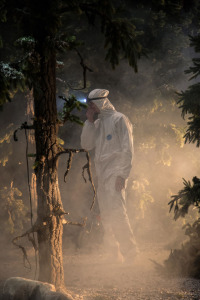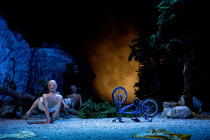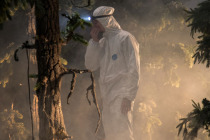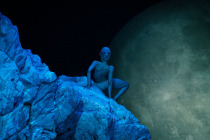19th Belgrade Dance Festival
Peeping Tom Brussels, Belgium
Book & Buy TicketsMarch 19th and 20th 2022 / 20h
Large Stage of Madlenianum
Child
concept, direction: Gabriela Carrizo, Franck Chartier
creation, performance: Eurudike De Beul, Marie Gyselbrecht, Hun-Mok Jung, Brandon Lagaert, Yi-chun Liu, with the help of Maria Carolina Vieira
artistic assistance: Lulu Tikovsky
sound composition: Raphaëlle Latini, Hjorvar Rognvaldsson, Renaud Crols, Annalena Fröhlich, Fhun Gao, Peeping Tom
sound mixing: Yannick Willockx, Peeping Tom
light design: Amber Vandenhoeck, Sinan Poffyn (intern), Peeping Tom
costume design: Lulu Tikovsky, Yi-chun Liu, Nina Lopez Le Galliard (intern), Peeping Tom
set design: Justine Bougerol, Peeping Tom
set construction: KVS-atelier, Flora Facto, Peeping Tom
props: Nina Lopez Le Galliard (intern), Silvio Palomo (intern)
technical direction: Filip Timmerman
light engineer: Hadrien Lefaure
sound engineer: Hjorvar Rognvaldsson
tour manager: Helena Casas
communication manager: Sébastien Parizel
company manager: Veerle Mans
duration: 80’
premiere: Theatre de la Ville de Luxemburg, 2019.
production: Peeping Tom
co-production: KVS – Koninklijke Vlaamse Schouwburg Brussel (BE), Teatre Nacional de Catalunya / GREC Festival de Barcelona (ES), Theater im Pfalzbau Ludwigshafen (DE)
Coproduction: Les Théâtres de la Ville de Luxembourg (LU), deSingel Antwerpen (BE), Théâtre de la Ville Paris / Maison des Arts de Créteil (FR), Maison de la Culture de Bourges (FR), Festival Aperto / Fondazione I Teatri Reggio Emilia (IT), La Rose des Vents Villeneuve d’Ascq (FR), Théâtre de Caen (FR), Gessnerallee Zürich (CH), La Bâtie – Festival de Genève (CH), Julidans Amsterdam (NL), Le Manège Maubeuge (FR)
Onstage, the child. As the main character, is a disturbing presence. The audience sees a girl who is far too large riding a bike that is far too small for her. Her skirt is too short, and her flesh bulges out of the ends of her sleeves and socks. The mezzo-soprano Eurudike De Beul does not play the part of that child, she is that child. The simple fact that she is visibly long past her childhood years renders the confrontation with her world all the more disturbing for the audience. The gap results in an effect that we could qualify as the “uncanny valley”: a disturbing excess of resemblance that cannot but impose an increased awareness of the potential implications. With her infantile tics and gestures, this disproportionate child leads us into her universe: a somber forest at the foot of menacing cliffs. Although she lives in an environment that we are familiar with, she also slips, without any visible transition, into a primitive state that we have forgotten, on the fraying borders of the unconscious: a state where the earth speaks, where children grow on trees, and where strange events, rather than alarming anyone, only spark curiosity.
After “Vader” (2014) and “Moeder” (2016), “Kind” (“Child”, 2019.) is the third part of Peeping Tom’s family trilogy that explores the themes or memory, recollections, and the tragic search for links. In this piece, Gabriela Carrizo and Franck Chartier explore the sources of psychosis from the point of view of the child. In “Child”, the presence of “real” children is limited to an extra who is cast in the place where the production is being performed. Still, during the period prior to the creation and rehearsal of “Child”, Peeping Tom organized a series of workshops with children of different age groups in a number of cities. This allowed the directors and the performers to gain a better understanding of the plastic and artistic potential of children: the gestures children use, the way they see the world, the way they see the adults around them, and the way that expresses itself in their gestures and body language. And to gain more insight into how children deal with certain fears, fears that are essentially the result of an absence of support and framework, as for example when they cannot count on their parents. How do they manage absence, loss, conflicts?
Born in Argentina in 1970, Gabriela Carrizo started dancing at a multidisciplinary school when she was 10. Until the age of 19 she dances and creates her first choreographies with the University for Ballet in Córdoba. She moves to Brussels to work with Caroline Marcadé and within next few years she is engaged in different projects in Paris and Brussels. In 1994 she creates solo “Et tutto sara d’ombra et di caline” and from 1995, she works with Alain Platel for the performances “La Tristeza Complice” and “Iets op Bach”. Furthermore, she works with Needcompany for the production “Images of affection” and with Alain Platel she creates the choreography for the opera ”Wolf”. In 2000, she establishes the dance theatre company Peeping Tom with Franck Chartier. Their first productions were “Caravana” and “Une Vie Inutile”. From 2002 to 2007, they created the famous trilogy “Le Jardin” (2002), “Le Salon” (2004) and “Le Sous Sol” (2007). The trilogy was followed by “32 rue Vandenbranden” (2009) and “A Louer“ (2011). In 2013, Carizzo created “The missing door” for NDT 1. Later she directed “Moeder”, as part of the trilogy about the family, starting with “Vader” and ending with “Kind”. The performances “A Louer”, “32 rue Vandenbranden”, “Vader” and “Diptych: The missing door and The Lost Room” were presented at the Belgrade Dance Festival.
Born in France in 1967, Franck Chartier started dancing at the age of 11. He trained ballet at Rosella Hightower’s Dance Center in Cannes until 1986. At the age of 19, he joins Maurice Béjart’s Ballet of XX Century in Brussels and moves to Switzerland, where he stays until 1989. After that, he works with Angelin Preljocaj and creates the show “Le spectre de la Rose” at the Paris Opera. In 1994 he moves to Brussels to work with Rosas. Together with Alain Platel he creates “Iets op Bach”, which inspires him to continue his own work. In 2000 he establishes the dance company Peeping Tom, together with Gabriela Carrizo. They create “Caravana”, “Une vie Inutile”, the acclaimed trilogy “Le Jardin” (2002), “Le Salon” (2004) and “Le Sous Sol” (2007), followed by “32 rue Vandenbranden“ (2009) and “A Louer“ (2011). With “Vader“, Peeping Tom started a second trilogy, centered around the family members. This first leg is directed by Franck Chartier. In collaboration with NDT 1 and following Carrizo’s “The missing door“, Chartier directed “The Lost Room“.
Thoughout of last 20 years, Peeping Tom has grown from an ad-hoc collective that met during a production by Alain Platel and, with scarce resources, created a surprising production (“Caravane“, 1999), to an established company with national and international renown. The trilogy consisting of “Le Jardin“ (2001), “Le Salon“ (2004) and “Le Sous Sol“ (2007), as well as “32 rue Vandenbranden“ (2009) and “A Louer“ (2011) are international co-productions that have been received with enthusiasm by press and audiences alike, and have toured extensively. At the core of Peeping Tom are its artistic directors Gabriela Carrizo and Franck Chartier. Gathered around them is a group of highly diverse artists with whom they have formed long-term collaborative arrangements. Their wide-ranging interests, together with the distinctiveness of their performers, create a highly original cross-disciplinary choreographic language. Given their background in dance, movement and image are the most important means of involving the audience in the intimacy on stage. Carrizo and Chartier define this intimacy as the rendering visible of and zooming in upon that which is invisible, which at first sight appears insignificant, and which is essential but denied or glossed over. The human condition is at the core of Peeping Tom’s artistic project. The productions involve the staging of parallel worlds, discontinuous universes, in which the customary logic of time, space and atmosphere is disrupted.
This landscape of the untamed imagination may be about childhood, but “Child” is not a children’s show. You’ll leave wanting to treat children not just with care, but with caution.
© The Guardian
“Child” is full of queasy moments. Its means are bizarrely bold but the emotional pathology portrayed is all too real.
© The Stage
The realistic environment is transformed into a series of strange and surrealistic images, with figures in a hostile atmosphere. At the same time, it also shows the real joy of theatre, because it shows things that have never been seen and is an emotional experience, like a dream.
© La Repubblica
The true Picasso of ballet are Franck Chartier and Gabriela Carrizo.
© Cultureel Persbureau
An evil Alice in the land of horrors.
© Diario de Sevilla




